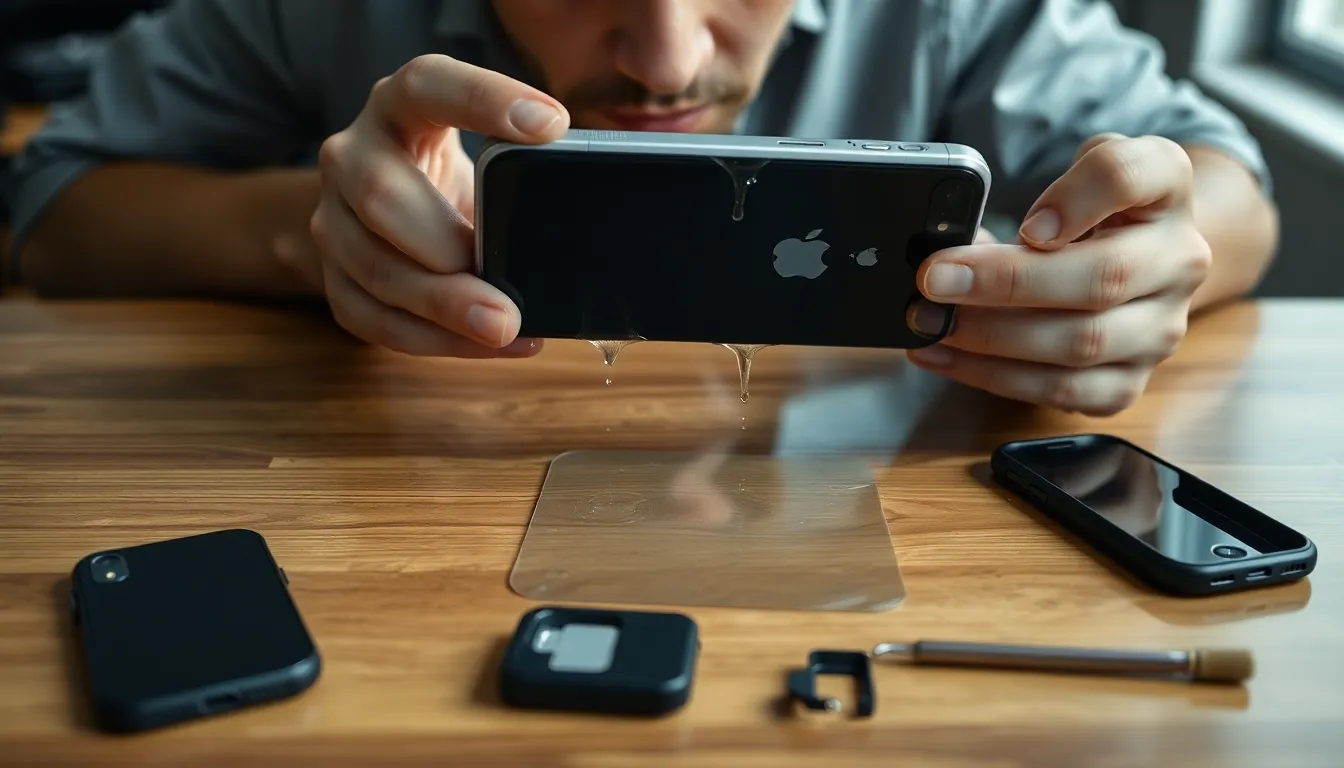Accidents happen, and sometimes that splash of water can turn your iPhone’s camera into a blurry mess. Whether it’s a rogue wave at the beach or an unexpected downpour, nothing dampens the mood like a soggy smartphone. But don’t panic just yet; there’s hope for your beloved device.
Table of Contents
ToggleUnderstanding the Issue
Water damage can significantly affect an iPhone camera’s functionality and image quality. Accidental exposure to liquid poses risks that users should address promptly.
Why Water Damage is Problematic
Water can cause internal corrosion, leading to permanent damage. Affected cameras might display issues with clarity, resulting in blurry or distorted images. Additionally, moisture inside the device creates the potential for electrical short circuits. When the internal components suffer, features like autofocus and image stabilization may fail. The extent of the damage often corresponds to the duration of exposure to moisture. Immediate action increases chances of recovery; neglecting the situation can exacerbate the problem.
Signs of Water in Your Camera
Identifying water intrusion in an iPhone camera involves observing certain indicators. Foggy lenses typically indicate moisture buildup. Users might also notice unexpected changes in image quality. Water spots inside the camera housing can appear, confirming the presence of liquid. Furthermore, the presence of condensation in the lens is a clear signal. In some cases, the camera may fail to function completely. Heeding these signs can help users take timely steps to mitigate potential harm.
Immediate Actions to Take

Taking immediate action is crucial when dealing with water in an iPhone camera. Quick measures can greatly reduce potential damage.
Power Off Your iPhone
Powering off the iPhone prevents electrical malfunctions. A quick shutdown stops the device from running critical operations while moisture is present. Hold the side button and either volume button until the power off slider appears. Slide to power off. This action minimizes the risk of short circuits occurring inside the device. Using the iPhone after water exposure increases the potential for significant, permanent damage.
Remove Accessories and SIM Card
Removing accessories and the SIM card helps prevent further complications. Start by taking off any cases, screen protectors, or attachments that might trap moisture. Next, gently remove the SIM card using a SIM eject tool or paperclip. Leaving the SIM card out allows for better ventilation and quick drying of areas where water might hide. Taking these initial steps creates a safer environment for drying the device, which is essential for recovery.
Step-by-Step Guide on How to Get Water Out of Camera iPhone
Taking immediate action is crucial when water infiltrates an iPhone camera. Several effective methods exist for addressing this issue.
Using Drying Agents
Drying agents help absorb moisture efficiently. Common agents include uncooked rice and silica gel packets. To use a drying agent, place the iPhone in a sealed bag filled with the chosen agent. They typically remain in the bag for 24 to 48 hours for optimal results. Check for any signs of moisture before attempting to power the device back on.
Employing Rice Method
The rice method remains a popular choice among users. First, ensure the iPhone is powered off and remove any accessories. Next, completely submerge the device in uncooked rice, leaving it there for at least 48 hours. Rice absorbs excess moisture; however, it’s essential to keep the phone in a warm, dry environment. After the drying period, inspect the device for any lingering moisture before turning it on.
Utilizing Silica Gel Packs
Silica gel packs offer a fast-acting moisture removal method. These packets contain a high absorption capacity, making them ideal for drying electronics. To utilize silica gel, place the phone in a container with multiple packets surrounding it. Allow it to sit for 24 to 48 hours for effective drying. Regularly check for moisture; once the iPhone appears dry, test its functionality.
Additional Techniques to Prevent Future Damage
Preventing future water damage to an iPhone camera requires proactive measures. Using waterproof cases offers significant protection against moisture. These cases create a barrier, safeguarding the phone during outdoor activities or adverse weather conditions. Many available options provide different levels of water resistance, so selecting one that meets individual needs is essential.
Regular maintenance also plays a vital role. Keeping the iPhone clean and dry ensures better performance and longevity. Users should routinely inspect ports and speaker grills for debris. Periodic checks for any signs of wear or damage further enhance device reliability. Additionally, updating the iPhone software helps ensure optimal functionality and security, reducing the likelihood of risks associated with water ingress. Adopting these strategies enhances the device’s resilience against water and extends its usability.
Taking immediate action is crucial when water gets into an iPhone camera. By following the outlined steps and using effective drying methods, users can significantly improve their chances of salvaging their device. Regular maintenance and the use of protective cases can prevent future incidents, ensuring the camera remains functional and clear.
Staying proactive about moisture exposure not only preserves image quality but also extends the overall lifespan of the iPhone. With the right approach and care, users can navigate the challenges of water damage and keep their devices in top condition.


